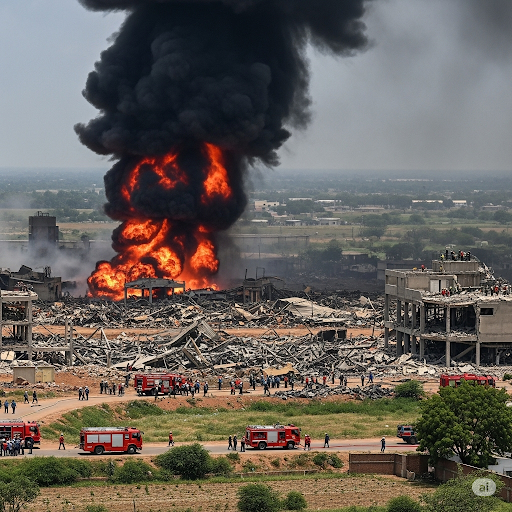A tragic incident unfolded at Sigachi Industries, a chemical factory located in the Pashamylaram industrial area of Sangareddy district, Telangana, on Monday, June 30, 2025.
Here's a detailed breakdown of the incident:
The Explosion and Fire:
The blast occurred around 9:48 AM in the drying unit of the Sigachi Pharma Company.
Initial reports suggested a reactor blast, but the company later clarified that it was likely a dust explosion in the dryer section, possibly due to overheating of microcrystalline cellulose (MCC) powder. MCC is a combustible material.
The explosion was so powerful that its impact was felt across a 5 km radius, causing significant structural damage and leading to the collapse of a three-story building within the factory.
The blast immediately triggered a massive fire that engulfed parts of the industrial unit.
Eleven fire tenders were deployed, and fire personnel worked relentlessly to bring the blaze under control.
Casualties and Injuries:
The incident has resulted in a devastating loss of life. As of Friday, July 4, 2025, the death toll has risen to 39, with one worker succumbing to injuries at a private hospital.
At least 33 people were injured, with some initially in critical condition and on ventilator support. As of July 4, 12 injured individuals have been discharged.
The high number of casualties is attributed to the presence of workers from two shifts (general and night) who were reportedly having a meeting at the time of the explosion.
Many of the deceased were burnt beyond recognition, making identification difficult. DNA profiling is underway by the Telangana Forensic Science Laboratory (TGFSL) to identify the victims, with 50 sets of samples already collected.
Among the deceased are migrant workers from states like Odisha, Bihar, and Uttar Pradesh.
There were initially reports of 9 to 10 workers still missing, and rescue teams continue to search through the debris for any remaining traces, including body parts and personal belongings.
Rescue and Response Operations:
National Disaster Response Force (NDRF) and State Disaster Response Force (SDRF) teams, along with local police and fire services, were immediately deployed for rescue and relief operations.
Earthmovers were used to clear the debris and search for trapped workers and bodies.
Telangana Chief Minister Revanth Reddy visited the blast site and expressed grief, announcing compensation of Rs 2 lakh from the Prime Minister's National Relief Fund for the deceased and Rs 50,000 for the injured. Sigachi Industries also announced an ex-gratia of ₹1 crore to the families of the deceased and full medical and rehabilitation support for the injured.
Investigation and Causes:
The exact cause of the blast is still under investigation.
While the company initially denied it was a reactor blast, experts now believe it was likely a dust explosion in the dryer section due to overheating of microcrystalline cellulose (MCC) powder.
Authorities are investigating whether safety protocols were followed, including the functioning of the interlocking system that should cut off heat at predetermined levels.
Initial investigations have revealed multiple safety violations by Sigachi Industries. These include the alleged absence of a mandatory fire safety certificate (Fire NOC), improper handling of flammable materials (MCC), and a lack of recent third-party safety inspections. Workers had also reportedly warned the management about unsafe machinery.
A four-member expert committee has been constituted by the state government, including senior chemical scientists and safety officers, to investigate the cause of the explosion and recommend preventive measures. They are tasked with submitting a report within a month.
An FIR has been registered against the company management under sections related to culpable homicide not amounting to murder, voluntarily causing grievous hurt, and attempting to commit culpable homicide.
Context and Concerns:
This incident marks one of the deadliest industrial accidents in the history of Telangana and Andhra Pradesh, and highlights recurring concerns about industrial safety lapses and regulatory failures in the region's chemical and pharmaceutical sectors.
Environmentalists and experts have long flagged concerns about industrial zones like Pashamylaram and Patancheru, stressing the need for stricter enforcement of safety regulations, periodic risk assessments, and modern fire suppression systems.
The factory, built in 1989, reportedly operated without current fire clearance or a No Objection Certificate (NOC), taking advantage of legal exemptions.
The investigation is ongoing, and further details are expected as authorities continue to clear the site and analyze evidence. The focus remains on ensuring justice for the victims and implementing stringent measures to prevent such tragedies in the future.



No comments:
Post a Comment